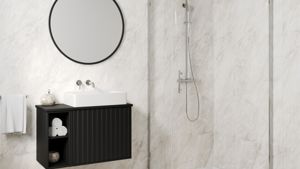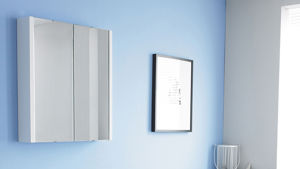When you’re in the market for a new radiator there are many things that you need to take into account, chief among which is what your radiator is going to be made from. In this guide we’ll talk you through the pros and cons of each material to help you find the perfect radiator(s) for your home. Most radiators on the market are made of one of four materials. Click on each one to find out more:
Mild Steel
Mild steel is by far the most common radiator material. It’s so popular in fact, that almost all of the radiators that you’ve ever seen have probably been made from mild steel. There are many reasons for this. Firstly, mild steel radiators are cheap to produce, which makes them cheap to buy for you. Mild steel towel warmers start from under £25 with mild steel radiators starting from under £100.
No other radiator material can compete with mild steel when it comes to the amount of different designs and finishes on offer. If you’re looking for a radiator that’s as much a work of art as it is a contraption to warm your home, then you’ll have plenty of options to choose from.
Strength is another key area in which mild steel radiators perform well. If you’ve ever accidentally knocked your elbow or knee on a mild steel radiator, you’ll understand. They’re built to be solid, and if properly looked after they can last generations. Just look at the radiators in schools and old office buildings; most would have been there since the building was constructed.
Just as with everything in life, no matter how many positives there are, there are always going to be some negatives. Fortunately for mild steel radiators, these are few and far between. The major downside of mild steel radiators is that they are prone to rusting from the inside, especially if you have a combi-boiler or mega flow (closed) system in your house. This is why they typically come with shorter guarantees than the other materials. It’s not all doom and gloom though. Internal rusting can easily be prevented by making sure that your boiler is regularly serviced and an inhibitor is added to the system. This prevents rust from forming in your water system and gathering on the inside of your radiators. As long as you do this, you can expect a mild steel radiator to last a lifetime.
Stainless Steel
Stainless steel radiators share many of the same properties as mild steel radiators. They’re strong, they come in an ever increasing array of designs, and they are built to last. One difference with mild steel radiators, however, is the resistance to rust and corrosion of a stainless steel radiator. Rusting from the inside shouldn’t be an issue for a stainless steel radiator, although it’s still definitely beneficial to keep your system topped up with an inhibitor just to be safe. After all, a radiator rusting from the inside because of rust in your water system will not be covered under the manufacturer’s guarantee.
Thanks to the anti-rust, anti-corrosive and anti-stain properties of stainless steel, however, most stainless steel radiators come with a lengthy guarantee - typically between 5 and 25 years. Anti-rust properties don’t mean that are 100% rust resistant though. If you have a habit of leaving sopping wet towels on your towel warmer or radiator, you may find rust forming on the outside of the radiator. That is why we advise against putting wet towels on radiators and heated towel rails; after all they’re called heated towel warmers, not towel dryers. If rust does form on your stainless steel towel warmer, however, this shouldn’t alarm you as it’s not actually the radiator rusting and it should be quite simple to wipe off.
Stainless steel radiators do have their downsides, but they are minimal. When compared to mild steel radiators they are considerably more expensive, although it’s still possible to pick one up for around £200. When you consider the fact that it will most likely last a lifetime and require much less maintenance, the initial extra outlay is worth it if your budget allows. There are also fewer styles and fancy finishes than mild steel radiators, although with more manufacturers focusing more of their time on stainless steel radiators, that is likely to change.
Aluminium
Aluminium is the latest material of choice for radiator manufacturers. It is what is known as a super conductor and what this means is that it produces a lot more heat than any other type of radiator. If you were to line up identical sized mild steel, stainless steel, cast iron and aluminium radiators, the aluminium radiator would produce two to three times the BTUs of the others. This means that you can heat the same sized room with a much smaller radiator, or you could get away with buying just one radiator instead of two or three.
Aluminium radiators heat up and cool down very quickly thanks to their super conductivity, so they are also the best at regulating the temperature of a room. Added to that, they are extremely lightweight, and so a good choice to hang on a stud wall that might not be able to take the weight of a 50kg steel radiator.
Of course aluminium does have its downsides as a radiator material. If it didn’t, it would be the only material used to build radiators. As you might expect from a super conductor, aluminium radiators are expensive, and though the price is coming down as their popularity increases, don’t expect them to be near the price of a steel radiator.
We mentioned that one of the pros of aluminium radiators is that they are light, but this can also be seen as a downside as well. Aluminium radiators are light because the aluminium used in them is very thin, but this also makes them fragile. Whilst you could quite literally bang your head against a steel radiator all day (not recommended) and not even make a dent, the slightest knock on an aluminium radiator can damage it. That’s not to say that they’re not well made - a good aluminium radiator will still come with a lengthy guarantee - you just have to think more carefully about where you might be placing it. If it’s in a busy living room and you have kids running around all the time, you might be better off with a more sturdy steel radiator.
Cast Iron
The first radiators were made from cast iron, and whilst technology has moved on, cast iron radiators are not only still available, but they are making a comeback. If you want the traditional look in your home, they are the only choice. One of the benefits of cast iron radiators is that they are incredibly well built and they are even stronger and heavier than steel radiators. In terms of heat output, they are about as efficient as steel and stainless steel radiators, but the way they put out that heat differs enormously from them.
Cast iron radiators take a long time to warm up, so you can’t just turn them on when you start to feel cold; you have to be prepared and turn them on in expectancy of being cold. Whilst they take a long time to heat up - money that you might think is being wasted - they hold their heat exceptionally well, so they can usually be turned off soon after getting up to temperature and you’ll find they have heat in them for hours. So in actual fact, you’ll find that they’re probably on for around the same length of time as a steel radiator.
Whilst cast iron radiators are the most expensive option, no other material can give you the same traditional look, so if that’s what you have your heart set on you’ll be disappointed with anything else. If you buy a cast iron radiator/radiators for your house, it’s also highly unlikely that you’ll have to buy another radiator ever again.
So, there we have it; a brief look at the four main materials for radiators. We hope that you have found this helpful in choosing the right material for your next radiator. Be sure to keep an eye out for our upcoming blogs on the many different types of radiators, as well as a special blog focusing on electric and dual fuel radiators.








